 |
||
|
||
| ||
Technologies December was marked by a sharp revival in the camp of the lithographic equipment manufacturers. And it was about not only a successful release of new tools. The time has come to determine the supplier of the next generation equipment for Intel. As it's known, despite problems with deliveries of 193 nm equipment, Intel has dealt with problems and started to release 0.13 micron processors, using already available 248 nm tools from SVG and Nikon. By the way, Pentium 4 processors with Northwood core will also be made with 248 nm equipment. The company is going to use new 193 nm tools only on transition to 0.09-micron technical process. At once three companies are known to apply for the role of the supplier of such equipment - ASML, Canon, and Nikon. Nikon was the first to achieve success: single amount deliveries of its 193 nm NSR-S306C lithographic tools have already been addressed to Intel.  Nikon NSR-S306C ASML still remains the potential "supplier #2", though Canon's positions have also grown considerably stronger in December. In the middle of the month this Japanese company has announced the release of three new lithographic tools: 193 nm argon fluoride (ArF) FPA-5000AS3 scanner, 248 nm krypton fluoride (KrF) FPA-5000ES4 scanner, and i-line FPA-5500iX stapler.  Canon FPA-5000AS3 The productivity of these new tools inspires respect: 193 nm FPA-5000AS3 and 248 nm FPA-5000ES4 are capable of processing up to 105 and 110 300-mm plates per hour accordingly, or up to 160 200-mm plates per hour. The advantage of 193 nm Canon FPA-5000AS3 model with low aberration (4:1) optics and the numerical aperture (NA) of 0.75 is that such a tool can be used to produce 0.10 micron and smaller chips. The main advantage of the new 193 nm Canon's tool is its calcium fluoride (CaF2) projective system and the opportunity of mass (if it is possible to speak about mass production in such manufacture) deliveries in the second or third quarter of 2002. In December ASML was active as well and announced the delivery of the first two-level 193 nm Twinscan AT:1100 lithographic system with Carl Zeiss's projective system (NA 0.75) for working with 300 mm plates. The customer was unnamed, but many think it was Intel.  ASML Twinscan AT:1100 Intel representatives have already announced that the company will prefer to partner with only two suppliers of 193 nm tools. And now, prior to the beginning of 2003 (when 0.09 micron technical process is to be launched), there is time and the company, most likely, gets acquainted with production of all three manufacturers, chooses the most productive and favourable variants. By the way, the price of one 193 nm system is about $20 million. By the way, AMD does not stand still as well and plans to start it's own 0.09 micron technical process in the nearest 1-1.5 years. As it's known, ASML, that always was the traditional supplier of lithographic equipment for AMD, has decided to terminate the development of 193 nm SVG Micrascan V scanner and combine this project with the Twinscan. For the time being it was possible to say with confidence that ASML will be the supplier of the new equipment for AMD. However, rumors in the beginning of December, that Infineon and AMD negotiate the creation of a joint venture, may radically change the situation. There's still no exact information about this enterprise, there is only a forecast, that the expected bargain sum may make 15 billion marks ($6,87 billion), and the enterprise will have a factory and a research centre. If these rumors are even partly true, a curious situation may arise. Infineon is known to be an active participant of the joint development with Canon of the first generation 157 nm fluorine (F2) exposition systems with a high NA parameter for working with 70 nm components. The samples of such systems are already planned to the first half of 2003, and their implementation at Infineon factories - to the beginning of 2005. Here is a question about the real benefits of AMD and Infineon cooperation... We shouldn't also write off 248 nm DUV lithography: in December ASML has informed about the release of the new 248 nm krypton fluoride (KrF) scanner capable of providing 0.11 micron (110 nm) technical process norms with 300 mm silicon plates. The new Twinscan AT:850B with the complete set of Starlith 850 projective optics (NA 0.80) from Carl Zeiss is the first 248 nm step-and-scan tool capable of providing such resolution level. 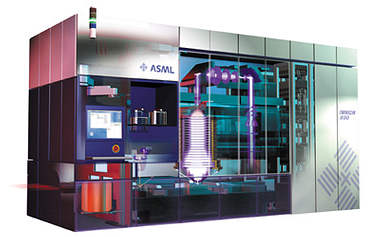 ASML Twinscan AT:850B Besides, the two-level work method (scanning one plate while exposing the second), that allows to process up to 95 300-mm plates per hour, is also unmatched among 248 nm systems. The first AT:850B scanner has already been delivered to a "leading Asian consumer". ASML owns SVG that has "exposed" Intel last summer with deliveries of 193 nm scanners for 0.13-micron chips manufacture. ASML has decided to terminate the development of the independent line of 193 nm SVG Micrascan V scanners and combine this project with the Twinscan. Nevertheless, after the purchase of SVG in the beginning of the year for 1.6 billion, the incorporated company got some capacity surpluses. In December ASML announced that it had found the buyer for a part of lithographic optics manufacture division. The buyer was the North American SSG Precision Optronics Inc., developing and releasing optical subsystems for aerospace industry. The rest of Tinsley Laboratories that has been a part of SVG before, bringing up to $12 million income per year, will be transformed to ASML Optics Inc. subsidiary. I shall mark that forecasts of marketing companies for the forthcoming year and the development of electronic industry has become much softer in December rather than, for example, in September / October. Despite the radical change of industry development rates, analysts promise that in 2002 there will be some better manufacture, if not its expansion. So, there's less pessimism about the nearest future now, and time has come to look back and see who has suffered most. Certainly, it was the transition of companies to 300-mm plates manufacture that had suffered most. The majority of chip manufacturers only start transition to 300 mm equipment, rather painful as funds for capital construction have considerably suffered due to the heavy financial situation of 2001. The slowness of introduction of 300 mm process had very badly affected hardware and software vendors which in due time (1997-1999) had spent billions for development of 300 mm equipment, still remaining unclaimed in a majority. As a whole, analyst forecasts are that by 2003 (according to iSuppli) only 8.2% of all factories will be equipped with the modern equipment for 300 mm silicon plate production. By the end of 2005 such enterprises will make no more than 14%, and the launch of the first factories for working with 450 mm plates is at all pushed from 2008 to 2013. In December Hynix and TSMC announced the launch of 0.13-micron manufacture, but each company did it in its way. Hynix has announced the installation of equipment necessary to produce memory chips and the beginning of pilot manufacture of 0.13-micron microchips (mass production of 0.13 micron DRAM will begin in the summer 2002). TSMC, already having several lines for 0.13-micron chips production, have announced the development of new 0.13-micron technical process that will allow to compromise between productivity and power consumption depending on concrete properties of the chip. The new process, positioned as the addition to the base specification created a year ago, offers designers more opportunities for productivity increase at preservation of the low power consumption. The large-scale manufacture with application of the new variant of technology is expected to begin already in the beginning of 2002. But it's unknown what chips will be made with it (perhaps, distressful Crusoe TM5800?). However, in December TSMC was noted by one more high technology: in joint venture with North American Matrix company, TSMC developed the method of three-dimensional chip manufacture, transistors can be positioned in both horizontal, and vertical planes. The most interesting is that such 3D microchips can be produced with the standard factory equipment using existing technical processes and usual materials. At that TSMC announced that during researches it developed the technology of nonvolative 3D memory. The commercial release of this technology is planned for the next year. In December HyperTransport Technology consortium announced the release of the final 1.03 version of the interface specification. In December the camp of HyperTransport admirers was updated with such a serious authority, as Hewlett-Packard. ProcessorsDecember appeared laconic enough for Intel. Perhaps, except for reduction of prices for Pentium III (256 Kb L2 cache) and Pentium III-S (512 Kb L2 cache) processors right at the beginning of the month, and the release of box versions of server processors, I can mark just the launched manufacture of ProLiant 590/64 servers based on Compaq Computer's Itanium processors. As it's known, the manufacture of these systems was postponed in November because of some problems with their serviceability. However, January is close and so is the new generation of 64-bit processors - McKinley - to be announced in that month. As it's known, processors will work with i870 chipset. Actually, the mass appearance of these processors is expected only in the second quarter of 2002. 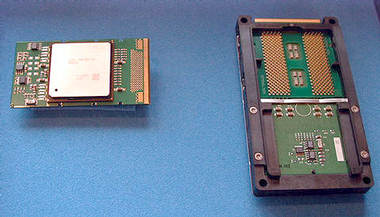 Intel McKinley On the preliminary data, Intel will release 1 GHz version of McKinley with 3 Mb cache for $4220, 1 GHz version with 1.5 Mb cache for $2240 and 900 MHz version with 1.5 Mb cache for $1330. McKinley processors, as well as the present Itanium, will be made with use of 0.18-micron technical process. 0.13-micron technical process for 64-bit processor manufacture will be used only in 2003 when the thing will be about Madison and Deerfield. Serious news from Intel is expected in January, 2002. And not only in the 64-bit field. Right at the beginning of the month 0.13 micron Socket 478 Pentium 4 processors with Northwood core will be released with these clock frequencies: 1.6 GHz, 1.8 GHz, 2.0 GHz, and 2.2 GHz; 512 Kb of L2 cache and 1.5V core supply voltage. 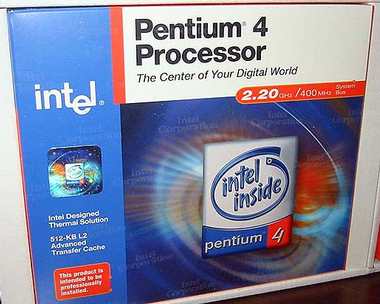 2,2 ÃÃö Intel Northwood Then, as it's expected, there will be introduced 0.13 micron 2.0 GHz and 2.2 GHz Socket 603 Xeon Pentium 4 server processors with Prestonia core, 1.5V core supply voltage, and 512 Kb of L2 cache. 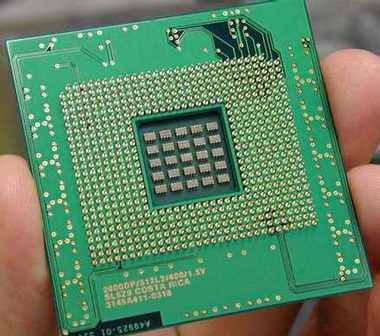 2,0 GHz Intel Prestonia AMD had a bit more "cheerful" December. For a start, for example, having pleased its admirers with the new green color of textolite of Athlon XP processors. 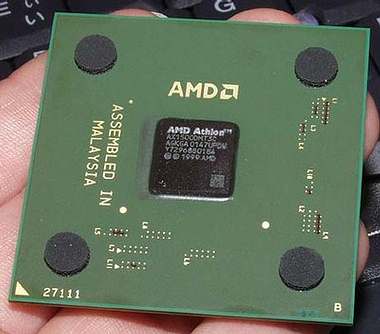 "Green" AMD Athlon XP 1500+ As it was found out, all AMD Athlon XP processors will become "green" already in the first half of 2002. As a matter of fact, the change of textolite color is only an aesthetic PR action, aimed at conformity of processor color to the company's brand color and not introducing any functional or price changes. In December AMD released the new Athlon MP 1900+ processor for the server market. 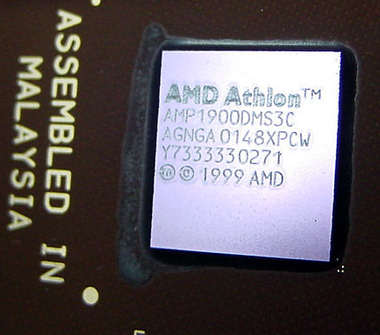 AMD Athlon MP 1900+ Athlon MP 1900+ is the next model of Athlon MP line for dual-processor systems with Palomino core. It is marked according to QuantiSpeed doctrine, the real processor frequency makes 1.6 GHz. This model, as well as the junior, features SmartMP and 3DNow! Professional. The new processors were already noticed in the Japanese retail in the end of December. In December 1 GHz mobile Duron was announced for the market of portable personal computers. As its predecessors it's equipped with 192 Kb of cache total, supports FSB 200 MHz, 3DNow! Professional instruction set and PowerNow! energy saving technology. Compaq and IBM have mentioned plans about release of notebooks on this processor. Hopes of those who expected the new 2000+ version of Athlon XP in December (with real clock frequency 1.667 GHz) were not justified. The novelty will appear only in January, and only in 0.18-micron implementation with Palomino core. The appearance of Thoroughbred version is expected after the end of the first quarter of 2002. Also the first quarter of 2002 should bring us 0.13 micron Duron processor with Appaloosa core. Still there are suspicions that releasing only 1.3 GHz Duron for the first three months of 2002, might narrow AMD's market share of low-end processors. In December Taiwanese VIA Technologies released 933 MHz version of 0.13 micron VIA C3 processor with Ezra core. Like its predecessors of C3 line, the processor is compatible with Socket 370, equipped with 128 Kb of L1 cache and 64 Kb of L2 cache, supports FSB 100/133 MHz, MMX and 3DNow! instruction set.  933 MHz VIA C3  Besides, in December VIA announced the integrated Eden platform that, as the company plans, should "stuff" every possible electronics - digital television boxes, game consoles, digital tape recorders, domestic servers, routers, POS terminals, etc.  Eden ESP6000 VIA especially emphasizes that power consumption of VE1400, VE1500, VE1600, VE2400, VE2500, or VE2600 systems, based on new processors of Eden line (ESP4000, ESP5000, ESP6000, actually, variations of chips with Samuel II or Ezra cores), in combination with integrated north bridges (PLE133 or PN133T), south bridges (VT8231/VT82C686B), and a set of standard peripheral controllers (IEEE 1394, USB 2.0, TV-out, Ethernet) will not exceed 6W. It's tempting! Despite the fact that, according to the company, the announced solutions are already being partly delivered, and another part will appear in the first quarter of 2002. As far as it's known, nobody received such systems for testing. Therefore, it's still early to speak about the efficiency of Eden line and its real performance. Transmeta's situation is absolutely poor: it has become known that once again they are "finishing preparations for release" of 0.13 micron Crusoe TM5800 processor; it is expected in mass quantities only in February, 2002. The previous closing date of TM5800 release was in December, and now it has been moved again. In January we also awaits news from Apple that is going to show working systems based on the fifth generation of Motorola's PowerPC processors on Macworld in San Francisco. G5, or PowerPC 8500 will be available in 32- and 64-bit versions, equipped with completely redesigned pipeline; it will support Rapid IO open bus architecture with FSB 400 MHz, and also multiprocessor operation mode. Processors will be produced with use of the new 0.13 micron Motorola HiP7 process, the first samples having 800 MHz clock frequency; 2 GHz and higher models are expected further. It was unexpected enough that Palm has chosen Texas Instruments as the supplier of the new OMAP platform. During the tender realization TI competed with Intel's XScale and Motorola's DragonBall platforms. Palm plans to use OMAP architecture that consists of ARM processor core and specialized DSP-processors developed by TI, for integration in the new generation of PDAs. MotherboardsThe main event of December is Intel's release of the first DDR chipset - i845D, or as it is also called, i845 step B (i845B0). The company plans to vigorously promote the new chipset. For this purpose Intel has already reduced the price for SDRAM 845A3 version, and has also promised that DDR version will be $2 cheaper from the beginning of 2002. Besides, it seems that confusion with Pentium 4 processor form-factors came to the end at last: it seems that Socket 478 has become the standard for Pentium 4 systems, and Socket 423 processors are not calculated by millions anymore. At least, there were no such announcements of i845D boards for out-of-date Socket 423 in the stream that rushed after December, 16. There were many boards announced with the new chipset. The majority of companies went beyond releasing one or two boards, and have literally presented all possible variants. So, ASUS, for example, released P4B266 in three variants at once: the standard P4B266 (ATX), P4B266-M (MicroATX), and with P4B266-E with integrated IDE RAID controller.  ASUS P4B266-E Intel itself began selling at least three versions of i845 step B boards - the standard D845BG, D845BGL (with 10/100Base-TX LAN controller), and D845PTL (MicroATX).  Intel D845BG Undoubtedly, everyone expects the official release of the new 0.13-micron Pentium 4 processor with Northwood core to estimate the full serviceability of the modern DDR/Pentium 4 platform. And now you can familiarize yourself with the productivity of this new chipset on the example of Intel D845BG board (see our Intel D845BG on i845D review). At last AMD has officially presented the new AMD-760MPX chipset for dual-processor systems, being the development of already known AMD-760MP and distinguished from the previous version by the south bridge with 66 MHz PCI bus support. Now, AMD-762 + AMD-768 couple will be used instead of the AMD-762 + AMD-766 bundle.  AMD-760MPX AMD-762 has supported 66 MHz PCI before as well, but now AMD-760MPX motherboards feature the opportunity of installing up to two PCI-64/66 MHz slots, that will undoubtedly increase the appeal of such boards for server and cluster systems. I shall say that AMD-768 features AC'97 support, and AMD-760MPX itself still does not demand separate cooling despite its increased complexity. Boards, based on AMD-760MPX, were released by ASUS (A7M266-D), Tyan (Thunder K7X), Gigabyte (GA-7DPXDW), EpOX (M762A), MSI (K7D266-L), and ABIT (WA-2A) in November at Comdex Fall 2001. Versions from ASUS and MSI have already been noticed in Japanese retail by the end of the month. In December Tyan had time to release another board with the new chipset - Tiger MPX (S2466) - something like a "light" (as against Thunder K7X) variant without additional integrated SCSI and VGA controllers onboard. In December VIA has officially announced VPX Modular I/O Expansion technology and presented the first chip of VPX family - VPX-64 64-bit PCI controller. Prototypes of VPX systems were shown already in the spring at Computex 2001. VPX-64 (VT8101) chip is the additional controller, adding the support of 33 MHz / 66 MHz 64-bit PCI bus with up to 533 Mb/s bandwidth to already released VIA's DDR chipsets - VIA Apollo Pro266T and VIA Apollo P4X266/P4X266A, that is critical for server components such as Gigabit Ethernet, Fibre Channel, and Ultra SCSI/320. VT8101 supports up to four 64-bit/66 MHz PCI slots and up to six usual 32-bit/33 MHz PCI slots. Still there were no announcements of motherboards with VT8101 even from VIA itself. Perhaps, they follow the New Year.  The mobile DDR chipset - ProSavageDDR KN266, being the successor of VIA ProSavage KN133, was announced for AMD platform. KN266 works with mobile AMD Athlon 4 and AMD Duron processors, is equipped with S3 Graphics ProSavage8 graphic core integrated into North Bridge, and enables work with low-voltage DDR266 memory. KN266 is compatible with all versions of VT8233 line south bridges and is equipped with all features of a modern chipset, including integrated two-channel LVDS transmitter and the complete AMD PowerNow! 2.0 support. As a whole, VIA's business wasn't bad in December. Besides announcements of boards based on popular KT266A chipset and appearing novelties based on updated P4X266A, VIA itself, already as the motherboard manufacturer, has announced the release of P4X266A boards of P4XB line. There are two ATX boards announced for the present: P4XB-RA and P4XB-SA, distinguished by that the first of them is equipped with integrated 6-channel audio (C-Media CMI8738) and the IDE RAID controller (Promise PDC20265R).  VIA P4XB-RA The second - is a bit lighter: without RAID controller, sound hardware is AC'97 codec (Realtek ALC201A). For more information about these and other novelties based on VIA P4X266A chipset see our article "VIA P4X266A chipset and the comparative research of boards based on it and the previous VIA P4X266 version. Taiwanese SiS can truly brag of the perfect month, its chipsets being now in great demand. No, they did not announce any new chipsets in December. The company tries to deal with already made orders. The 500 thousand units of announced delivery plan for December shows the deficit of boards based on SiS645 and SiS735 chipsets, and announcements of novelties based on integrated versions - SiS650, SiS740 follow one by one... Besides, for SiS December became the month of large orders for SiS645 chipset from Hewlett-Packard, boards for whom will be made by ASUS, and also Compaq, that was not chosen its OEM-supplier yet. That's not a surprise: at excellent productivity and fine characteristics, the price of SiS645 chipset is $10 less than the price of Intel 845D, that's already suffices for a steadfast attention from brands. The one really interesting novelty of the month based on SiS chipsets is a whole ASUS's P4S333 family of SiS645 boards. Besides P4S333 ATX and P4S333-M MicroATX versions, ASUS has also presented the interesting P4S333-FX FlexATX version. 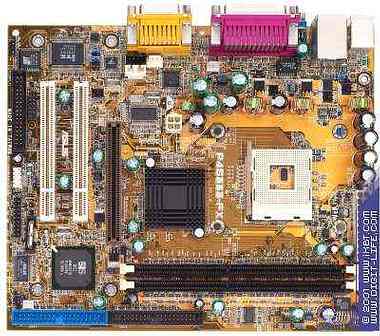 ASUS P4S333-FX Unfortunately, I can't say that ALi's chipsets take over more vital space. Despite the fact that the company expects to finish the year positively, it will be achieved not because of sales of chipsets for desktop PCs, but first of all, due to increased demand for its controllers for DVD products, and also notebook chipsets. Some words about ATi's production that's still absent in the market, but whose announcements are expected in the first quarter of 2002. Still they are about PIII and Athlon A3 chipsets for desktop PCs with integrated Radeon 7000 graphic core, and also their U1 analogs for notebooks. As it's expected, A3 will be inexpensive, within the limits of $30, and on condition of good features, may quite expect its market share. A4 DDR chipset with the same Radeon 7000 core is expected in the second quarter, but for Pentium 4 processors, including their mobile variants. Memory productsDecember was marked not only with new memory products. After DRAM manufacturers had become desperate, but, nevertheless, could settle everything last month, so prices raised and the next stage of situation has started. As analysts predicted, the time has come to sweep small companies from the market, consolidate capacities, and expand enterprises. Micron was, perhaps, the most active newsmaker in December. It had begun with that Infineon and Toshiba could not settle the merge of capacities for memory products manufacture. The very next day after the announcement of the unsuccessful end of negotiations, Toshiba has informed about the sale of its Dominion Semiconductor LLC subsidiary with the factory in Virginia, USA to Micron Technology. Besides, Toshiba has also announced the full refusal of mass DRAM presence in the market, switching attention to the release of specific memory kinds jointly with Micron. All manufacture of Toshiba's NAND flash-memory will be transferred to Japan territory where it will be produced together with Sandisk; up to 10% of the personnel will be dismissed before March, 2002; and assembly operations will be trusted to third party companies. Moreover: RDRAM release for the PC market was said to be unprofitable, and Toshiba has decided to limit the release of this memory to Sony Playstation 2 game consoles. Toshiba is just a vivid example of the company leaving all unstable sectors of the memory products market in every way, occupying only prospect niches (for example, flash-memory) where sales are unconditionally guaranteed (long-term contracts with Sony). Probably, losses, suffered by companies in 2001, have forced Toshiba management to decline risky methods of work. However, let's continue with Micron. For the whole month the Web was excited with the next details of Hynix Semiconductor - Micron Technology negotiations about possible merge. On the second round of negotiations, finished on December, 19, the details of possible alliance down to questions of managerial control were discussed. And still, the merge is not negotiated. Micron's point of view is understandable: even with closing all Hynix's factories after purchase, the company gets rid of the strong competitor with his dumping policy. If they succeed in negotiating with Hynix's board of creditors and begin the modernization of the purchased factories, the long-term success will be even more obvious. In any case, Samsung Electronics, the present world memory manufacturer #1, goes to the second place: according to analysts, Micron's market share is now estimated to 21%, Hynix's - 19%, Samsung - 23%. Hynix's benefit is also obvious: the company tries to diminish its multi-billion debt for a long time in different ways. Here Hynix creditors will be probably unanimous. Still, this situation doesn't go without complexities. Now Micron's available capital is estimated to approximately 1.6 billion, and the American company will have to pass up to 7-8% of its shares to Hynix creditors to achieve financial balance. Certainly, Micron would have preferred to refrain from exchanging its shares for Hynix shares because of the rather big debt of the latter. On the assumption of such financial situation it is possible to assume that besides a straightforward purchase of Hynix's factories, Micron may try to promote such a variant, as a joint venture with Hynix with partial association of factories. However, even if the variant with merge will fail, and cooperation will be partial, the technological partnership is, most likely, settled. It is already known that Hynix has decided to modernize its factories together with Micron. However, Hynix also has a spare variant in case of complete failure with Micron. In that case there will be neither significant reduction of chip production, nor the stop of Hynix's factories, but negotiations about possible alliance with Samsung may take place. I shall mark that relations of two Korean companies have become warmer recently: under the mutual arrangement Samsung and Hynix have increased purchasing prices for DRAM chips twice in December and they are, most likely, going to practise such synchronous actions further. Anyhow, memory prices have been increasing for the whole December: SDRAM price has slightly increased, DDR SDRAM price has increased much more significantly, but RDRAM has slowly become cheaper. The list of reasons to this may certainly contain the seasonal increase of demand, and the reduction of product release of Hynix, Hitachi, Toshiba, NEC, Fujitsu, Powerchip, and Winbond, and also the beginning of integration processes. What memory prices will be in the spring is unknown. But it's clear: summarized losses of memory product manufacturers for 2001 will nevertheless be a bit lower than predicted in fall, and this will allow the majority of them to continue factory modernization, though hardly. And now it's time to recollect the real novelties appeared in the memory market past month. Samsung has presented 36 MBit samples of three promising SRAM types: QDR II, DDR II, and NtRAM (No Turnaround Random Access Memory), which will be produced from the middle of 2002 with the use of 0.15 micron technical process. QDR II and DDR II are high-speed SRAM with HSTL (High Speed Transceiver Logic) support, designed for High-end routers and switchboards. For the most requiring multiport switchboards Samsung offers NtRAM capable of synchronous reading and writing without starting a new cycle that theoretically allows to achieve 100% of memory bus efficiency. New SDRAM types will be feature 1.8V, 2.5V, and 3.3V working voltage and 165FBGA (QDRII), 153BGA/165FBGA (DDRII), 0TQFP/119BGA/165FBGA/209BGA (NtRAM) form-factors. December brought us many versions of promising DDR333 chips. So, Nanya was the first to announce the beginning of the mass production of both DDR333 chips, and complete PC2700 modules, preliminary certified by Asustek, Gigabyte and MSI. The prospective yield of 256 Mb modules in December is up to 700 thousand units, prospective price of PC2700 is approximately 30% higher than that of PC2100.  In December Elpida started deliveries of sample consignments of 512 Mb DDR SDRAM memory modules, based on its own chips produced with the use of 0.13 micron technical process, with CAS=2.5 and the working voltage of 2.5V. Despite the decision about reduction of DRAM product release announced in November, Taiwanese Winbond Electronics, nevertheless, announced the beginning of mass production of 0.13 micron 512 MBit DDR SDRAM memory chips. On the background of significant increase of DDR memory prices, Winbond had time in December to change the decision about product release reduction. In case of favorable results of negotiations with Infineon, Winbond will begin re-equipping its 0.13 micron capacities for 0.11 micron technical process already with the German company, as its former partner, Toshiba is terminating this direction. At the end of the month Hynix has announced the
beginning of release of 128 MBit DDR SDRAM chip samples with 375
MHz work clock frequency produced with the use of 0.16-micron technical
process. First of all, such chips will be delivered in mass amounts
(already in the first quarter of 2002) to manufacturers of graphic
cards for desktop and portable computers.
Write a comment below. No registration needed!
|
|
Platform · Video · Multimedia · Mobile · Other || About us & Privacy policy · Twitter · Facebook
Copyright © Byrds Research & Publishing, Ltd., 1997–2011. All rights reserved.